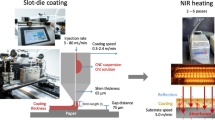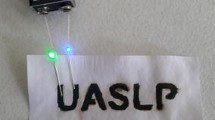Abstract
CuO nanoflakes with dimension of 50–150 nm × 200 nm were successfully immobilized on the surface of cellulose fibers by an ultrafast (5 min reaction time), scalable microwave assisted method. The high retention of CuO up to 70% has been phenomenal considering that the immobilization was carried out in the absence of any linker, binder or retention aid. Retention of almost 87% of the immobilized CuO nanostructures even after five consecutive recyclability steps has been unprecedented. The antimicrobial activities of the paper matrices have been investigated by deactivating both G. trabeum and E. coli. The CuO immobilized paper matrices have desisted the growth of G. trabeum up to 28 days and completely deactivated E. coli (CFU in order of 107) in the presence of visible light with exposure time of 2 h only.
Graphical abstract








Similar content being viewed by others
References
Adel AA, Ahmed NM, Diab MA, Selim MM (2016) The influence of TiO2/CC core/shell pigments on the properties of paper sheets. Powder Technol 291:437–447
Agarwal C, Aggrawal S, Dutt D, Mohanty P (2018) Cerium oxide immobilized paper matrices for bactericidal application. Mater Sci Eng B 1:232–235
Aggrawal S, Chauhan I, Mohanty P (2015) Immobilization of Bi2O3 nanoparticles on the cellulose fibers of its antibacterial activity against E. coli in visible light. Mater Exp 5:429–436
Aggrawal S, Mandal T K, Mohanty P (2019). Ag+ driven antimicrobial activity of Ag+: ZnO nanowires immobilized on paper matrices. Materialia 8:100490
Alrammouz R, Podlecki J, Vena A, Garcia R, Abboud P, Habchi R, Sorli B (2019) Highly porous and flexible capacitive humidity sensor based on self-assembled graphene oxide sheets on a paper substrate. Sens Actuat B Chem 298:126892
Cao K, Liu H, Li W, Han Q, Zhang Z, Huang K, Jing Q, Jiao L (2019) CuO nanoplates for high-performance potassium-ion batteries. Small 15:1901775
Chauhan VS, Bhardwaj NK (2012) Effect of particle size of talc filler on structural and optical properties of paper. Lignocellulose 1:241–259
Chauhan I, Mohanty P (2014) Immobilization of titania nanoparticles on the surface of cellulose fibres by a facile single step hydrothermal method and study of their photocatalytic and antibacterial activities. RSC Adv 4:57885–57890
Chauhan I, Mohanty P (2015) In situ decoration of TiO2 nanoparticles on the surface of cellulose fibers and study of their photocatalytic and antibacterial activities. Cellulose 22:507–519
Chauhan I, Aggrawal S, Chandravati (2015a) Metal oxide nanostructures incorporated/immobilized paper matrices and their applications: a review. RSC Adv 5:83036–83055
Chauhan I, Aggrawal S, Mohanty P (2015b) ZnO nanowire-immobilized paper matrices for visible light-induced antibacterial activity against Escherichia coli. Environ Sci Nano 2:273–279
Chauhan I, Aggrawal S, Muhammad R, Mohanty P (2019) Immobilization of α-Fe2O3 nanoparticles on the cellulose surface: role of cellulose in tuning the microstructure and crystallographic phase. Cellulose 26:1757–1767
Ciabanu M, Bobu E (2009) Improving the recycleability of printing paper by in-situ filler loading. Environ Eng Manag J 8:307–313
Ciolacu D, Kovac J, Kokol V (2010) The effect of the cellulose-binding domain from Clostridium cellulovorans on the supramolecular structure of cellulose fibers. Carbohydr Res 345:621–630
Citak E, Istanbullu B, Sakalak H, Gursoy M, Karaman M (2019) All-dry hydrophobic functionalization of paper surfaces for efficient transfer of CVD graphene. Macromol Chem Phys 220:1900277
Dong P, Cheng X, Huang Z, Chen Y, Zhang Y, Nie X, Zhang X (2018) In-situ and phase controllable synthesis of nanocrystalline TiO2 on flexible cellulose fabrics via a simple hydrothermal method. Mater Res Bull 97:89–95
French AD (2014) Idealized powder diffraction patterns for cellulose polymorphs. Cellulose 21:885–896
Fujiwara K, Kuwahara Y, Sumida Y, Yamashita H (2017) Fabrication of photocatalytic paper using TiO2 nanoparticles confined in hollow silica capsules. Langmuir 33:288–295
Gadkari RR, Suwalka S, Yogi MR, Ali W, Das A, Alagirusamy R (2019) Green synthesis of chitosan-cinnamaldehyde cross-linked nanoparticles: characterization and antibacterial activity. Carbohydr Polym 226:115298
Gimenez AJ, Yanez-Limon JM, Seminario JM (2011) ZnO-paper based photoconductive UV sensor. J Phys Chem C 115:282–287
Habibie S, Hamzah H, Anggaravidya M, Kalembang E (2016) The effect of chitosan on physical and mechanical properties of paper. J Chem Eng Mater Sci 7:1–10
Iguchi Y, Ichiura H, Kitaoka T, Tanaka H (2003) Preparation and characteristics of high performance paper containing titanium dioxide photocatalyst supported on inorganic fiber matrix. Chemosphere 53:1193–1199
Johansson LS, Campbell JM, Koljonen K, Stenius P (1999) Evaluation of surface lignin on cellulose fibers with XPS. Appl Surf Sci 144–145:92–95
Khatri V, Halasz K, Trandafilovic LV, Dimitrijevic-Brankovi S, Mohanty P, Djokovic V et al (2014) ZnO-modified cellulose fiber sheets for antibody immobilization. Carbohydr Polym 109:139–147
Li X, Zhang K, Shi R, Ma X, Tan L, Ji Q, Xia Y (2017) Enhanced flame-retardant properties of cellulose fibers by incorporation of acid-resistant magnesium-oxide microcapsules. Carbohydr Polym 176:246–256
Liu X, Duan G, Li W, Zhou Z, Zhou R (2017) Membrane destruction-mediated antibacterial activity of tungsten disulfide (WS2). RSC Adv 7:37873–37880
Maheswari RU, Rani BJ, Ravi G, Yuvakkumar R, Ameen F, Al-Sabri A (2018) Structural, morphological, optical and antibacterial properties of pentagon CuO nanoplatelets. J Sol-Gel Sci Technol 87:515–527
Mahmoodi A, Solaymani S, Amini M, Nezafat NB, Mahmood G (2018) Structural, morphological and antibacterial characterization of CuO nanowires. SILICON 10:1427–1431
Manekkathodi A, Lu MY, Wang CW, Chen LJ (2010) Direct growth of aligned zinc oxide nanorods on paper substrates for low-cost flexible electronics. Adv Mater 22:4059–4063
Matsubara H, Takada M, Koyama S, Hashimoto K, Fujishima A (1995) Photoactive TiO2 containing paper: Preparation and its photocatalytic activity under weak UV light illumination. Chem Lett 24:767–768
Moghayedi M, Goharshadi EK, Ghazvini K, Ahmadzadeh H, Ranjbaran L, Masoudi R, Ludwig R (2017) Kinetics and mechanism of antibacterial activity and cytotoxicity of Ag-RGO nanocomposite. Colloids Surf B Biointerf 159:366–374
Monk PMS, Delage F, Vieira SMC (2001) Electrochromic paper: utility of electrochromes incorporated in paper. Electrochim Acta 46:2195–2202
Moon RJ, Martini A, Nairn J, Simonsen J, Youngblood J (2011) Cellulose nanomaterials review: structure, properties and nanocomposites. Chem Soc Rev 40:3941–3994
Mostafa AM, Mwafy EA, Lotfy VF, Basta AH (2019) Optical, electrical and mechanical studies of paper sheets coated by metals (Cu and Ag) via pulsed laser deposition. J Mol Struct 1198:126927
Mostafa AM, Lotfy VV, Mwafy EA, Basta AH (2020) Influence of coating by Cu and Ag nanoparticles via pulsed laser deposition technique on optical, electrical and mechanical properties of cellulose paper. J Mol Struct 1203:127472
Nishiyama Y, Langan P, Chanzy H (2002) Crystal structure and hydrogen-bonding system in cellulose Iβ from synchrotron X-ray and neutron fiber diffraction. J Am Chem Soc 124(31):9074–9082
Ogihara H, Xie J, Okagaki J, Saji T (2012) Simple method for preparing superhydrophobic paper: spray-deposited hydrophobic silica nanoparticle coatings exhibit high water-repellency and transparency. Langmuir 28:4605–4608
Ornatska M, Sharpe E, Andreescu D, Andreescu S (2011) Paper bioassay based on ceria nanoparticles as colorimetric probes. Anal Chem 83:4273–4280
Owen L, Laird K (2021) Development of a silver-based dual-function antimicrobial laundry additive and textile coating for the deccontamination of healthcare laundry. J Appl Microbiol 130:1012–1022
Patel M (2007) Minerals in paper manufacturing. Industry paper publications (M & P), Orissa, India
Pauly N, Tougaard S, Yubero F (2014) Determination of the Cu 2p primary excitation spectra for Cu, Cu2O and CuO. Surf Sci 620:17–22
Reddy RK (2017) Green synthesis, morphological and optical studies of CuO nanoparticles. J Mol Struct 1150:553–557
Sharmila G, Thirumarimurugan M, Sivakumar VM (2016) Optical, catalytic and antibacterial properties of phytofabricated CuO nanoparticles using Tecoma castanifolia leaf extract. Optik 127:7822–7828
Sirelkhatim A, Mahmud S, Seeni A, Kaus NHM, Ann LC, Bakhori SKM, Hasan H, Mohamad D (2015) Review on zinc oxide nanoparticles: antibacterial activity and toxicity mechanism. Nanomicro Lett 7:219–242
Small AC, Johnston JH (2009) Novel hybrid materials of magnetic nanoparticles and cellulose fibers. J Colloid Interface Sci 331:122–126
Spellberg B, Guidos R, Gilbert D, Bradley J, Boucher HW, Scheld WM et al (2008) The epidemic of antibiotic-resistant infections: a call to action for the medical community from the infectious diseases society of America. Clin Infect Dis 46:155–164
Sun S, Shi N, Liao X, Zhang B, Yin G, Huang Z (2020). Facile synthesis of CuO/Ni(OH)2 on carbon cloth for non-enzymatic glucose sensing. Appl Surf Sci 529:147067
Tan D, Zhang J, Yao L, Tan X, Cheng X, Wan Q et al (2020) Multi-shelled CuO microboxes for carbon dioxide reduction to ethylene. Nano Res 13:768–774
Taran M, Rad M (2016) Biological synthesis of copper nanoparticles by using Halomonas elongata IBRC-M 10214. Ind Textila 27:351–356
Villanueva ME, Diez AMR, Gonzalez JA, Perez CJ, Orrego M, Piehl L, Terves S, Copello GJ (2016) Antimicrobial activity of starch hydrogel incorporated with copper nanoparticles. ACS Appl MaterInterfaces 8:16280–16288
Willyard C (2017) The drug-resistant bacteria that pose the greatest health threats. Nature 543:15
Wright GD (2000) Resisting resistance: new chemical strategies for battling superbugs. Chem Biol 7:R127–R132
Xie Y, Hu X, Zhang Y, Wahid F, Chu L, Jia S, Zhong C (2020) Development and antibacterial activities of bacterial cellulose/graphene oxide-CuO nanocomposite films. Carbohydr Polym 229:115456
Xu JF, Ji W, Shen ZX, Tang SH, Ye XR, Jia DJ, Xin XQ (1999) Preparation and characterization of CuO nanocrystals. J Solid State Chem 147:516–519
Zeng X, McCarthy DT, Deletic A, Zhang X (2015) Silver/reduced graphene oxide hydrogel as novel bactericidal filter for point-of-use water disinfection. Adv Funct Mater 25:4344–4351
Acknowledgments
The work was financially supported by SERB, New Delhi, Govt. of India with Grant code: EMR/2016/001693.
Funding
Department of Science and Technology India, EMR/2016/001693, Paritosh Mohanty.
Author information
Authors and Affiliations
Corresponding author
Ethics declarations
Conflict of interest
The authors declare no competing financial interest. There is no animal studies or human participant involvement in the study.
Additional information
Publisher's Note
Springer Nature remains neutral with regard to jurisdictional claims in published maps and institutional affiliations.
Supplementary Information
Below is the link to the electronic supplementary material.
Rights and permissions
About this article
Cite this article
Aggrawal, S., Pradhan, D. & Mohanty, P. Microwave assisted ultrafast immobilization of CuO nanostructures in paper matrices for antimicrobial applications. Cellulose 29, 2633–2643 (2022). https://doi.org/10.1007/s10570-022-04457-1
Received:
Accepted:
Published:
Issue Date:
DOI: https://doi.org/10.1007/s10570-022-04457-1




